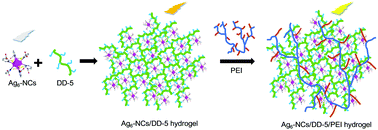Realizing enhanced luminescence of silver nanocluster–peptide soft hydrogels by PEI reinforcement†
Abstract
Metal nanoclusters (NCs) are a new type of fluorescent nanomaterial composed of several to several tens of metal ions or atoms with a wide range of applications in the fields of catalysis, optics, and biomedicine. However, fluorescence quenching when existing as individuals in aqueous solutions greatly limits their applications. In this study, six-core Ag(I) NCs (Ag6-NCs) were interacted with peptides (DD-5) in water to form soft hydrogels with the aggregation-induced emission (AIE) of Ag6-NCs. The introduction of polyethyleneimine (PEI) into the Ag6-NCs/DD-5 hydrogel succeeded in further enhancing the fluorescence intensity. This dual-AIE behavior of the Ag6-NCs/DD-5/PEI hydrogels is mainly ascribed to the strong hydrogen bonding among the carboxyl groups of Ag6, those of DD-5 and the amino groups of PEI, which effectively restricted intramolecular vibration of the capping ligands on the Ag6-NCs. Moreover, the addition of PEI can effectively promote the gelation speed of Ag6-NCs/DD-5 and act as a physical cross-linker, leading to an increase of the mechanical strength of the hydrogel. This work opens a new pathway for the fabrication of smart composite materials with multiple functions, which show a variety of applications such as chemical/biosensing and bioimaging.



 Please wait while we load your content...
Please wait while we load your content...